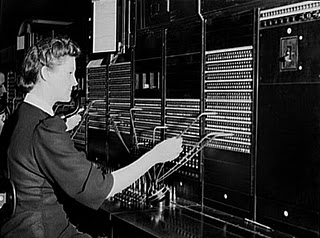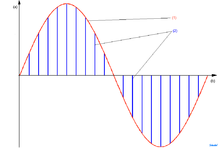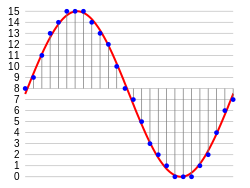Digital telephone systems for dummies. Part 1 - Voice Coding

Long ago, when the
Later, when digital technologies began to evolve more and more, the question arose, why not use them to transfer telephone conversations? The introduction of digital PBXs had quite a few positive points: the equipment began to take up less space, it became easier to maintain digital PBXs and diagnose, the configuration flexibility, scalability and reliability increased significantly. But one of the main innovations is time division of channels, and then packet data transmission. The advantage of time division of channels is that, roughly speaking, one line between PBXs at different points in time (time intervals) can be used by conversations of several pairs of subscribers, thus increasing the number of connections with a constant number of physical lines. In the case of packet transmission for the communication of two subscribers, there is no longer any need to permanently seize the line between PBXs, data (conversation) is transmitted in packets, and only when they are, at other times can the channel be used to transfer data from other subscribers. Also, when using packet transmission, it is easier to transfer other data over the same networks (for example, Internet traffic).
Well, I will try to tell what I know about digital systems as simply as possible, describing more of the principle of operation than some technical details, so perhaps there will be inaccuracies or inconsistencies with current standards somewhere. In any case, I will be happy with clarifications, corrections and suggestions.
So, question number one:
')
How is the conversation in digital systems?
Here pulse-code modulation (PCM, PCM, pulse-code modulation), known as Wikipedia claims , has come to the rescue since the beginning of the 20th century. You can read about it, for example, all in the same Wikipedia .
In order to convert an analog signal to digital, it is necessary to sequentially perform three operations on it: sampling, quantizing, and encoding.
Discretization is the acquisition of instantaneous values of a signal (samples) at certain intervals of time (that is, with a certain frequency — the sampling rate). In the picture: (1) - signal, (2) - samples.

Quantization is the "rounding" of the instantaneous values obtained to the nearest predetermined levels. For example, if we have 5 levels in increments of 2: 0, 2, 4, 6, 8, and some instantaneous values are 3.6, 7.1, 2, 0.5, 1.8, then they will be rounded to 4, 8, 2, 0, 2 respectively.

Encoding is the representation of the values of the obtained levels in the form of a code (for example, binary).
Now consider how the above happens in digital telephony.
Human speech occupies a frequency band of approximately 60–12000 Hz; however, for normal intelligibility, a frequency band of 300–3400 Hz is sufficient; the upper limit is 3.4 kHz. Anything above 3.4 kHz is “cut off” by the filter in order to avoid interference in the future. According to Kotelnikov's theorem , the sampling rate for representing an analog signal limited in spectrum (remember about the filter), in the form of samples, should exceed twice the upper frequency of the signal. For ease of calculation, as well as some margin, the upper limit is rounded to 4 kHz. Thus, the sampling frequency in our case is 8 kHz.
Quantization and coding are almost always integral parts of each other. Quantization in digital telephony is uneven, 256-level. Non-uniformity of quantization is expressed in the fact that the quantization step (the distance between adjacent levels in units of measurement of the characteristics of an analog signal that is quantized; in this case, the signal voltage in volts) is chosen for small amplitudes for small amplitudes and for large ones for large ones. This is done to improve the accuracy of low-amplitude signal transmission. 256 quantization levels can be “fit” into one 8-bit binary number, thus one sample is represented as an 8-bit code combination. All 256 levels are divided into two groups: positive and negative. For positive signals, the first bit in the code combination is “1”, for negative signals - “0”. Each group is divided into 8 segments. Within one segment, the quantization step is unchanged, while it changes from segment to segment, increasing with increasing segment number. The following 3 bits are assigned to the segment number. The last 4 bits occupy the level number in the segment, all of these levels are 16. In total we have: 16 levels × 8 segments × 2 groups = 256 levels.
For example, the number “10010101” is a positive signal (1), with a level of 5 (0101) in the 1st segment (001).
Now you can calculate the speed of the received digital signal:
B = 8000 samples / s × 8 bits / sample = 64000 bits / s = 64 kbps.
These signals are the simplest signals in digital telephony. For their transmission, the main digital channels are used with a speed of 64 kbps. Companded signals that have a greater number of quantization levels can also be transmitted over these channels, but nevertheless, after companding, they still have 8 bits / count.
Thanks for attention.
PS Is it worth writing a sequel?
Source: https://habr.com/ru/post/133891/
All Articles